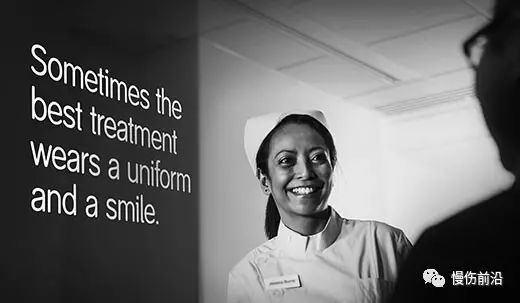
有时候最好的治疗就是你的专业和微笑-
Promise is a promise. 剩余的题全部在这里了。昨天的题目引起了很多老师的热烈讨论,主要是关于正确答案的,不过我们以为重要的在于思考过程,因为你发现,想要答对,可能并不能径直走向正确答案(“大牛”除外),同时需要了解很多相关背景知识,这也是这些题目有意思的地方吧。不过我们还是会认真总结,择期放送答案的。
21. 下列哪项关于水胶体敷料的使用是正确的:
- They require daily dressing changes.
需要每日更换 - They produce an odor.
有异味 - They are suitable for an infected wound.
适合用于感染伤口 - They are capable of absorbing large amounts of drainage.
可以吸收大量渗液
22. 下列哪项关于泡沫敷料的使用是正确的:
- Only if they will be changed daily.
每日更换 - On dry wound beds.
用于干燥伤口床 - Under compression therapy. 结合压力治疗使用
- To relieve pressure.
减压
23. 护士在换药时需要首先完成下列哪一步:
- Determining whether the patient requires pain management
决定患者是否需要疼痛管理 - Ensuring that all supplies are positioned close to the patient
确保所有换药所需置于患者旁边 - Removing the old dressing
揭除旧敷料 - Performing a wound assessment
进行伤口评估
24. 夹板在什么情况下用于急性伤口治疗:
- Patient is especially sensitive to pain.
患者对疼痛非常敏感 - Wound drainage is excessive.
伤口渗出非常多 - Risk of frequent joint movement will impair wound healing.
频繁的关节活动会妨碍伤口愈合 - Wound shows any signs of infection.
伤口有感染迹象
25. 采集伤口组织培养:
- Prior to cleaning the wound.
在清洗伤口之前 - From an area of necrotic tissue.
从坏死组织区域 - Following four weeks of wound treatment.
伤口治疗四周后 - Using a sterile technique.
使用无菌技术
26. 防止伤口感染的单一最有效的方法是:
- Changing the dressing frequently.
频繁更换敷料 - Handwashing.
正确洗手 - Wearing gloves.
戴手套 - Cleaning the wound with hydrogen peroxide.
使用双氧水冲洗伤口
27. 激素对伤口愈合的负面影响可以被下面哪一项局部治疗措施抵消:
- Vitamin C 维生素C
- Antibiotic ointment 抗生素软膏
- Hydrating gel 水凝胶
- Vitamin A 维生素A
28. 最常发生压力溃疡的身体部位是:
- Heels. 足跟
- Occipital area. 枕部
- Shoulder blades. 肩胛骨
- Coccyx. 骶尾部
29. 糖足溃疡形成的一个主要风险因素是:
- The loss of protective sensation.
失去保护性感觉 - Excessive ambulation.
过多的行走 - Wearing nylon socks.
穿着尼龙袜 - Jogging.
慢跑
30. 发生在糖尿病患者的下肢溃疡通常:
- Less painful when elevated.
抬高患肢时疼痛减轻 - Responsive to compression therapy.
压力治疗有效 - Located on the sole of the foot, with even wound margins.
位于足底,边缘整齐 - Dry and superficial, with irregular wound margins.
干燥和浅表,边缘不规则
31. 下列哪项是静脉溃疡的常见指针:
- Pale skin tone 皮肤苍白
- Tingling sensation in the toes
足趾刺痛感 - A brownish discoloration of the skin surfaces of the affected extremity
受累肢体皮肤呈棕褐色改变 - An intermittent throbbing pain in the affected extremity
受累肢体间歇性搏动疼痛
32. 在开始对静脉溃疡进行压力治疗前,应进行下列哪项评估?
- A pain tolerance test
疼痛耐受测试 - A venous ultrasound
静脉超声 - An Ankle Brachial Index (ABI) measurement
踝肱指数(ABI)检测 - A magnetic resonance imaging (MRI) scan of the lower extremities
下肢MRI扫描
33. 下肢动脉溃疡的特点是它们通常:
- Have a punched-out, pale appearance.
打孔样,外观苍白 - Are painless due to nerve damage.
由于神经损伤而无痛 - Produce large amounts of exudate.
产生大量渗液 - Respond well to compression therapy.
压力治疗有效
34. 出现在动脉溃疡患者的间歇性跛行通常表现为:
- Thin, shiny skin on the lower extremities.
下肢薄而发亮的皮肤 - Calf pain with ambulation.
行走时腓肠肌疼痛 - Severe ankle pain when the feet are elevated.
双脚抬高时严重的踝部疼痛 - Changes of skin temperature on the feet.
足部皮肤温度改变
35. 坏疽性脓皮病的一个典型特征是:
- Dark red streaks in the wound bed.
伤口床暗红色条纹 - Bleeding from the wound edges.
伤口边缘出血 - A purple halo around the wound.
伤口周围有紫色环 - A yellowish wound drainage.
发黄的伤口渗出液
36. 为儿童患者选择伤口敷料的一个特别挑战是:
- Large selection of products to choose from.
市场上大量可供选择的产品 - Higher cost for pediatric-specific products.
儿童专用产品价格较高 - Safety of products that were tested only on adults.
产品的安全性只在成人检验过 - Importance of complying with parental preference over patient preference.
满足家长喜好比满足患者喜好更重要
37. 防止脊髓损伤病人皮肤损伤的第一步是:
- Using body washes free of perfumes.
使用没有香料的身体清洗剂 - Learning correct transfer technique.
掌握正确的患者移动技术 - Recommending loose-fitting clothing.
建议患者穿着宽松衣物 - Encouraging bed rest.
鼓励患者卧床休息
38. 哪一项使临终安养病人更容易发生压力溃疡:
- Decreased food and fluid intake.
食物和液体摄入减少 - Elevated body temperature.
身体温度升高 - Confusion and restlessness.
意识不清,躁动 - Patient apathy.
淡漠
39. 以下哪项可以减少真菌感染伤口的异味:
- Performing less-frequent dressing changes.
减少敷料更换频率 - Using a waterproof dressing.
使用防水敷料 - Decreasing the amount of necrotic tissue in the wound.
减少伤口坏死组织 - Taking oral antibiotics.
服用口服抗生素
40. 负压伤口治疗敷料通常的更换频率是:
- Once a week. 每周一次
- Every 48 to 72 hours. 每48-72小时
- Daily. 每天
- As needed. 按需
41. 当患者在家更换敷料时,应该:
- Wash and dry their hands before starting the procedure.
换药前应该先洗手并晾干 - Change the dressing only when absolutely needed.
仅当绝对需要时才更换敷料 - Remove the old dressing as quickly as possible.
尽可能快地移除旧敷料 - Leave the wound uncovered for several hours.
敞开伤口数小时
内容转载自@慢伤前沿公众号!
